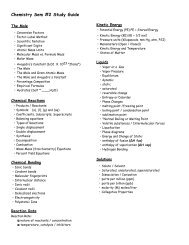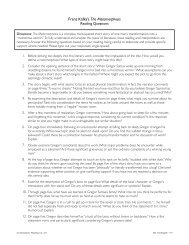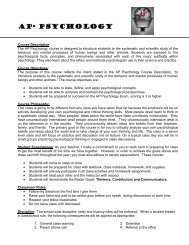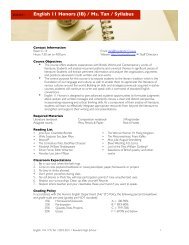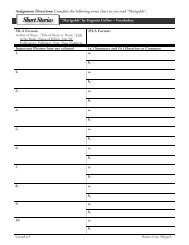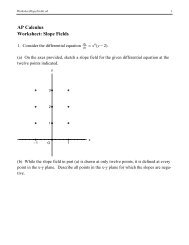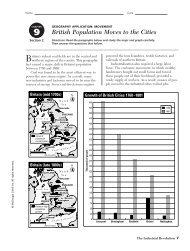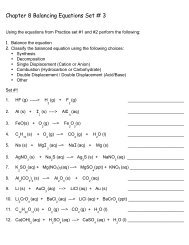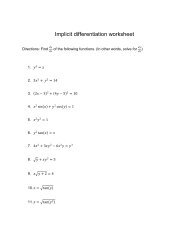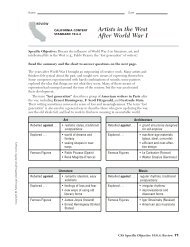APGeneticsLab
APGeneticsLab
APGeneticsLab
You also want an ePaper? Increase the reach of your titles
YUMPU automatically turns print PDFs into web optimized ePapers that Google loves.
Critical Values Table<br />
Degrees of Freedom (df)<br />
Probability (p) 1 2 3 4 5<br />
0.05 3.84 5.99 7.82 9.49 11.1<br />
0.01 6.64 9.21 11.3 13.2 15.1<br />
0.001 10.8 13.8 16.3 18.5 20.5<br />
How to use the Critical Values Table<br />
1. Determine the degrees of freedom (df) for your experiment. It is the number of phenotypic classes<br />
minus 1. Since there are two possible phenotypes, for this experiment df=1 (two samples -1). If this<br />
experiment had gathered data for a dihybrid cross, there would be four possible phenotypes and<br />
therefore 3 degrees of freedom.<br />
2. Find the p value. Under the 1 df column, find the critical value in the probability (p) = 0.05 row; it<br />
is 3.84. What does this mean If the calculated chi-square value is greater than or equal to the<br />
critical value from the table, then the null hypothesis is rejected. Since in our example χ 2 =<br />
5.14 and 5.14 > 3.84, we reject our null hypothesis that there is no statistically significant<br />
difference between the observed and expected data. In other words, chance alone cannot explain<br />
the deviations we observed and there is, therefore, a reason to doubt our original hypothesis (or to<br />
question our data collection accuracy.) The minimum probability for rejecting a null hypothesis is<br />
generally 0.05, so this is the row to use in s chi-square table.<br />
3. These results are said to be significant at a probability of p = 0.05. This means that only 5% of the<br />
time would you expect to see similar data if the null hypothesis was correct; thus, you are 95%<br />
sure that the data did not fit a 3:1 ratio.<br />
4. Since these data do not fit the expected 3:1 ratio, you must consider reasons for this variation.<br />
Additional experimentation would be necessary. Perhaps the sample size was too small, or errors<br />
were made in data collection. In this example, perhaps, the albino seedlings are underrepresented<br />
because they died before the counting was performed.<br />
Example 2<br />
In a study of incomplete dominance in tobacco seedlings, the counts in table 7.3 were made from a<br />
cross between two heterozygous plants.<br />
Table 7.3<br />
Phenotype Observed (o) Expected (e) (o-e) (o-e) 2 (o-e) 2<br />
Green 22<br />
Yellow Green 50<br />
Albino 12<br />
χ 2 =Σ (o-e) 2<br />
e<br />
A Punnett square for this cross indicates an expected ratio of 1 green:2 yellow green:1 albino.<br />
Calculate the expected for each and fill out the Table 7.3.<br />
How many degrees of freedom are there _______<br />
Using the critical values chart, what is the probability value for these data _____<br />
According to the critical value of χ 2 , can you accept or reject the null hypothesis (does the data fit the<br />
expected 1:2:1 ratio)<br />
e



